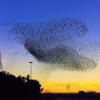You are here
Alain Brillet and Thibault Damour, 2017 CNRS Gold Medalists

The highest French scientific distinction, the CNRS Gold Medal, is awarded to two physicists, Alain Brillet and Thibault Damour, for their major contributions to the detection and analysis of gravitational waves. They will receive this prize—handed out by the CNRS management board—in person during a ceremony at the Collège de France on December 14, 2017. The two physicists will succeed mathematician Claire Voisin, winner of the 2016 Gold Medal.
The CNRS commends the major theoretical and instrumental contributions that enabled the first direct detection of gravitational waves, by the US-based LIGO's twin interferometers on 14 September, 2015. A century after Einstein predicted their existence, it took several months of analysis by scientists at LIGO and their colleagues in the Virgo collaboration (formed around the European detector of the same name) to confirm and announce, on 11 February 2016, the capture of gravitational waves emitted as a result of the coalescence of two black holes.
Born on 30 March 1947 in Saint-Germain-en-Laye (France), Alain Brillet joined the CNRS in 1970. From the beginning of his career, he focused on stabilized lasers, an entirely new field in France at the time. Attracted very early on by the detection of gravitational waves and by the scale of the scientific and instrumental challenges involved, he developed innovative solutions in the field of lasers and optics, which formed the basis for designing the Virgo interferometer. Between 1989 and 2003, he directed, then co-directed the consortium that operates this large instrument, which is today located in Cascina, near Pisa (Italy). In 2008, he became involved in the optics and overall design of the laser system of the second-generation detector, called Advanced Virgo. He is currently senior researcher emeritus at the CNRS, assigned to the Artemis laboratory (CNRS/Université Nice Sophia Antipolis/Observatoire de la Côte d'Azur). In 2016, he was awarded both the Ampère Prize of the French Academy of Sciences and the Special Breakthrough Prize in Fundamental Physics. He shares the latter with all other members of the LIGO-Virgo collaboration and with seven other researchers, including Thibault Damour, the other 2017 CNRS Gold Medalist.
An internationally renowned theorist for his breakthrough research on black holes, pulsars, gravitational waves and quantum physics, Thibault Damour was born on 7 February 1951 in Lyon. He passed the 'agrégation' (France's highest teaching diploma) in physics in 1974, and in 1977 joined the CNRS Department of relativistic astrophysics and cosmology at the Observatoire de Paris. Since 1989, he has been a tenured professor at the Institut des Hautes Études Scientifiques, at Bures-sur-Yvette, near Paris. This physicist played a role both in the indirect detection of gravitational waves in the 1980s, and more recently, in their direct detection. The first evidence for the existence of gravitational waves was obtained through the observation of PSR B1913+16, a binary system made up of a pulsar in orbit around a companion neutron star. The work carried out by Damour showed that in general relativity, the gravitational force acting on the pulsar propagated from its companion at light speed, in the form of waves, and that this propagation caused a slow decrease in its orbital period. Damour also played a crucial role in LIGO-Virgo's direct detection of gravitational waves by describing the motion of two black holes as they near each other, and by developing a new theoretical approach to describe their final merger and the resulting emission of gravitational waves.
Wednesday, September 27, 2017 will no doubt be remembered as a key date in the field of gravitational waves: the first LIGO-Virgo joint detection was also made public in the evening. Scientists were able to observe—for the first time with three detectors—gravitational waves emitted during the coalescence of two black holes. Although this phenomenon had already been observed by the LIGO interferometers in 2015 and 2017, this is the first detection by the Advanced Virgo instrument, confirming that the latter is now fully operational. This result, which is to be published in Physical Review Letters, paves the way for greater precision in locating the point of origin of gravitational waves. This result was presented in the evening on the sidelines of the "G7 Sciences," a meeting held between the science ministers of the G7 countries.
Another advantage of the Virgo detector is its orientation, which differs from the two LIGO interferometers. This allows scientists to perform new tests of Albert Einstein's theory of general relativity, which describes the force of gravitation. Indeed, this theory predicts that when a gravitational wave moves through space, the latter stretches in one direction and contracts in another, instead of—as alternative theories predicted—being deformed in only one, or all directions at the same time. The analysis of the signals observed indicated that the former was indeed correct. Yet these are only the first series of experiments as more extensive tests are already planned to further verify the theory of general relativity. Pending further observations (in fall 2018), the first data set of this three-detector network is still being examined and analyzed, and should soon yield more findings.














